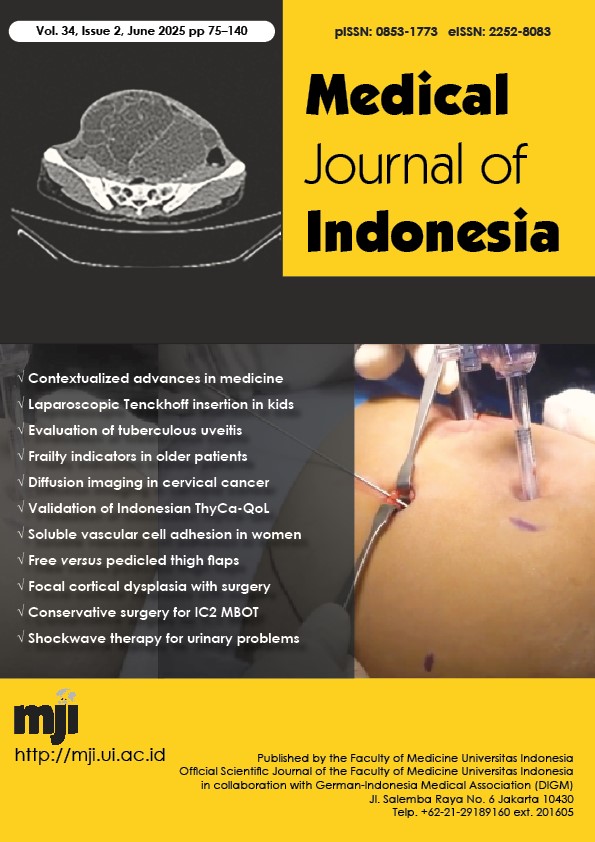Conservative surgery for stage IC2 mucinous borderline ovarian tumor: a five-year follow-up case report
DOI:
https://doi.org/10.13181/mji.cr.257637Keywords:
fertility preservation, ovarian neoplasms, salpingo-oophorectomyAbstract
Mucinous borderline ovarian tumors (MBOTs) represent a significant portion of all borderline ovarian tumors, including variants such as microinvasion and intraepithelial carcinoma, which have a higher recurrence risk. Conservative surgery is recommended for patients with MBOTs seeking fertility preservation, despite remaining a debated option to reduce recurrency. This case highlighted successful MBOT management using conservative surgery with unilateral salpingo-oophorectomy, providing insights into optimal recurrence control. A 30-year-old woman presented with abdominal enlargement, with imaging revealed a large right ovarian mass suspected to be malignant. A left salpingo-oophorectomy was performed, with final histopathology confirming MBOTs with microinvasion and intraepithelial carcinoma. No malignancy was found in the peritoneal fluid, and no adjuvant therapy was given due to fertility preservation reasons. No recurrence after 5 years of follow-up. This report highlights the potential of conservative surgery as a fertility-preserving option for young patients with stage IC2 MBOTs.
Downloads
References
Hauptmann S, Friedrich K, Redline R, Avril S. Ovarian borderline tumors in the 2014 WHO classification: evolving concepts and diagnostic criteria. Virchows Arch. 2017;470(2):125−42. https://doi.org/10.1007/s00428-016-2040-8
Ushijima K, Kawano K, Tsuda N, Nishio S, Terada A, Kato H, et al. Epithelial borderline ovarian tumor: diagnosis and treatment strategy. Obstet Gynecol Sci. 2015;58(3):183−7. https://doi.org/10.5468/ogs.2015.58.3.183
Chen RF, Tao X, Wu BB, Li J, Wang JY, Gu WY, et al. Mucinous borderline ovarian tumors with and without intraepithelial carcinoma: differences in clinicopathologic features and fertility results. J Obstet Gynaecol Res. 2020;46(4):646−53. https://doi.org/10.1111/jog.14210
Sahraoui G, Fitouri A, Charfi L, Driss M, Slimane M, Hechiche M, et al. Mucinous borderline ovarian tumors: pathological and prognostic study at Salah Azaiez Institute. Pan Afr Med J. 2022;41:349. https://doi.org/10.11604/pamj.2022.41.349.32332
Vasconcelos I, de Sousa Mendes M. Conservative surgery in ovarian borderline tumours: a meta-analysis with emphasis on recurrence risk. Eur J Cancer. 2015;51(5):620−31. https://doi.org/10.1016/j.ejca.2015.01.004
Wang P, Fang L. Salpingo-oophorectomy versus cystectomy in patients with borderline ovarian tumors: a systemic review and meta-analysis on postoperative recurrence and fertility. World J Surg Oncol. 2021;19(1):132. https://doi.org/10.1186/s12957-021-02241-2
Helpman L, Yaniv A, Beiner ME, Aviel-Ronen S, Perri T, Ben-Baruch G, et al. Fertility preservation in women with borderline ovarian tumors - how does it impact disease outcome? A cohort study. Acta Obstet Gynecol Scand. 2017;96(11):1300−6. https://doi.org/10.1111/aogs.13203
Hashmi AA, Naz S, Edhi MM, Faridi N, Hussain SD, Mumtaz S, et al. Accuracy of intraoperative frozen section for the evaluation of ovarian neoplasms: an institutional experience. World J Surg Oncol. 2016;14:91. https://doi.org/10.1186/s12957-016-0849-x
Fang C, Zhao L, Chen X, Yu A, Xia L, Zhang P. The impact of clinicopathologic and surgical factors on relapse and pregnancy in young patients (≤40 years old) with borderline ovarian tumors. BMC Cancer. 2018;18(1):1147. https://doi.org/10.1186/s12885-018-4932-2
Colombo N, Sessa C, du Bois A, Ledermann J, McCluggage WG, McNeish I, et al. ESMO-ESGO consensus conference recommendations on ovarian cancer: pathology and molecular biology, early and advanced stages, borderline tumours and recurrent disease†. Ann Oncol. 2019;30(5):672−705. https://doi.org/10.1093/annonc/mdz062
Sun L, Li N, Song Y, Wang G, Zhao Z, Wu L. Clinicopathologic features and risk factors for recurrence of mucinous borderline ovarian tumors: a retrospective study with follow-up of more than 10 years. Int J Gynecol Cancer. 2018;28(9):1643−9. https://doi.org/10.1097/IGC.0000000000001362
Lou T, Yuan F, Feng Y, Wang S, Bai H, Zhang Z. The safety of fertility and ipsilateral ovary procedures for borderline ovarian tumors. Oncotarget. 2017;8(70):115718−29. https://doi.org/10.18632/oncotarget.23021
De Decker K, Speth S, Ter Brugge HG, Bart J, Massuger LF, Kleppe M, et al. Staging procedures in patients with mucinous borderline tumors of the ovary do not reveal peritoneal or omental disease. Gynecol Oncol. 2017;144(2):285−9. https://doi.org/10.1016/j.ygyno.2016.11.035
Published
How to Cite
Issue
Section
License
Copyright (c) 2025 Tofan Widya Utami, Hiro Hidaya Danial Nasution, Arisda Oktalia, Fitriyadi Kusuma, Gatot Purwoto

This work is licensed under a Creative Commons Attribution-NonCommercial 4.0 International License.
Authors who publish with Medical Journal of Indonesia agree to the following terms:
- Authors retain copyright and grant Medical Journal of Indonesia right of first publication with the work simultaneously licensed under a Creative Commons Attribution-NonCommercial License that allows others to remix, adapt, build upon the work non-commercially with an acknowledgment of the work’s authorship and initial publication in Medical Journal of Indonesia.
- Authors are permitted to copy and redistribute the journal's published version of the work non-commercially (e.g., post it to an institutional repository or publish it in a book), with an acknowledgment of its initial publication in Medical Journal of Indonesia.






































